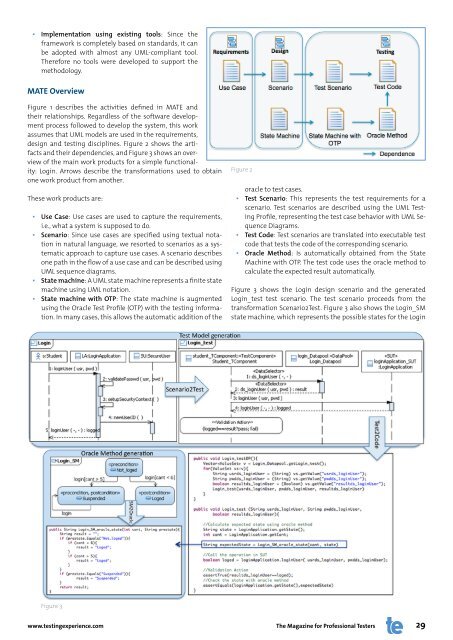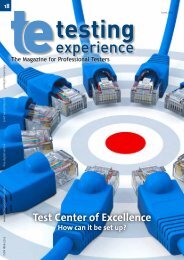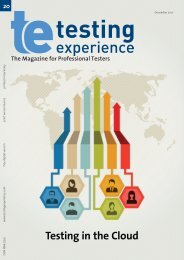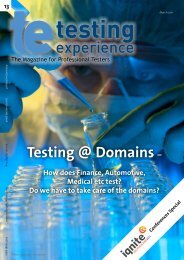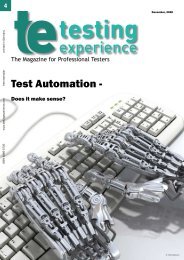Model-Based Testing - Testing Experience
Model-Based Testing - Testing Experience
Model-Based Testing - Testing Experience
You also want an ePaper? Increase the reach of your titles
YUMPU automatically turns print PDFs into web optimized ePapers that Google loves.
▪ Implementation using existing tools: Since the<br />
framework is completely based on standards, it can<br />
be adopted with almost any UML-compliant tool.<br />
Therefore no tools were developed to support the<br />
methodology.<br />
MATE Overview<br />
Figure 1 describes the activities defined in MATE and<br />
their relationships. Regardless of the software development<br />
process followed to develop the system, this work<br />
assumes that UML models are used in the requirements,<br />
design and testing disciplines. Figure 2 shows the artifacts<br />
and their dependencies, and Figure 3 shows an overview<br />
of the main work products for a simple functionality:<br />
Login. Arrows describe the transformations used to obtain<br />
one work product from another.<br />
These work products are:<br />
▪ Use Case: Use cases are used to capture the requirements,<br />
i.e., what a system is supposed to do.<br />
▪ Scenario: Since use cases are specified using textual notation<br />
in natural language, we resorted to scenarios as a systematic<br />
approach to capture use cases. A scenario describes<br />
one path in the flow of a use case and can be described using<br />
UML sequence diagrams.<br />
▪ State machine: A UML state machine represents a finite state<br />
machine using UML notation.<br />
▪ State machine with OTP: The state machine is augmented<br />
using the Oracle Test Profile (OTP) with the testing information.<br />
In many cases, this allows the automatic addition of the<br />
Figure 3<br />
www.testingexperience.com<br />
Figure 2<br />
oracle to test cases.<br />
▪ Test Scenario: This represents the test requirements for a<br />
scenario. Test scenarios are described using the UML <strong>Testing</strong><br />
Profile, representing the test case behavior with UML Sequence<br />
Diagrams.<br />
▪ Test Code: Test scenarios are translated into executable test<br />
code that tests the code of the corresponding scenario.<br />
▪ Oracle Method: Is automatically obtained from the State<br />
Machine with OTP. The test code uses the oracle method to<br />
calculate the expected result automatically.<br />
Figure 3 shows the Login design scenario and the generated<br />
Login_test test scenario. The test scenario proceeds from the<br />
transformation Scenario2Test. Figure 3 also shows the Login_SM<br />
state machine, which represents the possible states for the Login<br />
The Magazine for Professional Testers<br />
29


